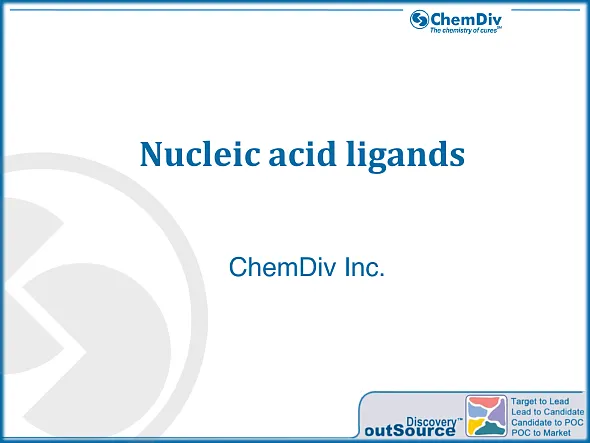Nucleic Acid Ligands
Nucleic Acid Ligands Library
ChemDiv’s Nucleic Acid Ligands Library contains 9,230 compounds.
DNA is currently seen as a potential pharmacological target in drug discovery, making it a vital focus in drug design due to the abundant and detailed structural information collected so far. Its critical functions in replication and transcription position it as a central target in the development of therapeutics against cancer, viral infections, and parasitic disorders. Furthermore, DNA is still a promising target for new therapies against those diseases. Effective DNA targeting in drug design necessitates highly selective engagements with specific nucleotide sequences as well as the ability to distinguish between the host DNA and that of a pathogen. In recent years, pharmacological research focusing on the selective binding of drugs to specific DNA sequences has garnered significant interest because of their potential applications in genomic research and clinical therapies. Consequently, it led to numerous structural studies, employing both experimental and theoretical approaches, devoted to the development of highly specific ligands targeting DNA sequences.
Due to the ease of access to chromosomal DNA, small molecules designed to bind to genomic DNA have been proven to be effective as anticancer, antibiotic, and antiviral therapeutic agents. The major portion of the DNA-interactive drugs are low molecular weight aromatic compounds, often carrying positive charges. The various modes of drug binding to DNA include intercalation between adjacent base pairs as well as insertion into the minor and major grooves. The predominant modes of DNA binding for small ligands are found to be intercalation and minor groove bindings [1].
Our nucleic acid ligand library contains a vast diverse set of compounds with confirmed selectivity to the DNA sequences and potential potency against above-mentioned therapeutic areas.
References
[1] Antonino Lauria, Paola Barraja, Gaetano Dattolo, and Anna Maria Almerico, “DNA Minor Groove Binders: an Overview on Molecular Modeling and QSAR Approaches,” Curr. Med. Chem., vol. 14, no. 20, pp. 2136–2160, 2007, doi: 10.2174/092986707781389673.
ChemDiv’s Nucleic Acid Ligands Library contains 9,230 compounds.
DNA is currently seen as a potential pharmacological target in drug discovery, making it a vital focus in drug design due to the abundant and detailed structural information collected so far. Its critical functions in replication and transcription position it as a central target in the development of therapeutics against cancer, viral infections, and parasitic disorders. Furthermore, DNA is still a promising target for new therapies against those diseases. Effective DNA targeting in drug design necessitates highly selective engagements with specific nucleotide sequences as well as the ability to distinguish between the host DNA and that of a pathogen. In recent years, pharmacological research focusing on the selective binding of drugs to specific DNA sequences has garnered significant interest because of their potential applications in genomic research and clinical therapies. Consequently, it led to numerous structural studies, employing both experimental and theoretical approaches, devoted to the development of highly specific ligands targeting DNA sequences.
Due to the ease of access to chromosomal DNA, small molecules designed to bind to genomic DNA have been proven to be effective as anticancer, antibiotic, and antiviral therapeutic agents. The major portion of the DNA-interactive drugs are low molecular weight aromatic compounds, often carrying positive charges. The various modes of drug binding to DNA include intercalation between adjacent base pairs as well as insertion into the minor and major grooves. The predominant modes of DNA binding for small ligands are found to be intercalation and minor groove bindings [1].
Our nucleic acid ligand library contains a vast diverse set of compounds with confirmed selectivity to the DNA sequences and potential potency against above-mentioned therapeutic areas.
References
[1] Antonino Lauria, Paola Barraja, Gaetano Dattolo, and Anna Maria Almerico, “DNA Minor Groove Binders: an Overview on Molecular Modeling and QSAR Approaches,” Curr. Med. Chem., vol. 14, no. 20, pp. 2136–2160, 2007, doi: 10.2174/092986707781389673.
